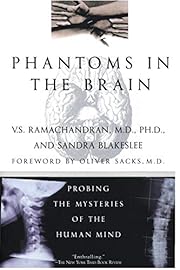

Auf ein Miniaturbild klicken, um zu Google Books zu gelangen.
|
Lädt ... Phantoms in the Brain: Probing the Mysteries of the Human Mind (Original 1998; 1999. Auflage)von V. S. Ramachandran (Autor)
Werk-InformationenDie blinde Frau, die sehen kann von V. S. Ramachandran (1998)
 Keine aktuelle Diskussion zu diesem Buch. This should have been called "how to amputate a phantom limb". Arguably the most famous neuroscientist, Ramachandran writes with beautiful insight. Even though it's 16 years old I'd recommend this book. I've read some criticism about his work and don't have the same religious views as him but deeply fascinating and elegant. The book is old, but I found the stories fascinating. However, there's a lot of speculation, and near the end the philosophic discussions and the speculation surrounding them began to drive me crazy. I'd be interested in his other book for the sake of learning more about the brain through examining patients with brain anomalies, but not all the philosophy. The book is old, but I found the stories fascinating. However, there's a lot of speculation, and near the end the philosophic discussions and the speculation surrounding them began to drive me crazy. I'd be interested in his other book for the sake of learning more about the brain through examining patients with brain anomalies, but not all the philosophy. This book, written by neurologist V. S. Ramachandran, suggests that by looking at case studies of individuals with particular types of brain injuries we can learn a lot about the the human mind. He looks at examples of patients with phantom limb syndrome, vision problems, paralysis and other problems and uses his understanding of their neurological (physiological) causes to speculate on their implications about the structure and functioning of a "normal" human brain. I found this very interesting to read, with descriptions of both symptoms and anatomy being very clear and easy to follow, although it is a little repetitive in places. However, although I know very little about neurology myself, I found some of his theories hard to swallow - it was often unclear if he was neglecting to mention the evidence he had to back them or if there was no evidence at all. I am particularly skeptical of his explanations for foot-fetishes and anorexia. A quote which I think sums up Ramachandran's view of the brain well: "Freud's most valuable contribution was his discovery that your conscious mind is simply a facade and that you are completely unaware of 90 percent of what really goes on in your brain." keine Rezensionen | Rezension hinzufügen
AuszeichnungenBemerkenswerte Listen
Funktionen des Gehirns, dargestellt und erläutert an schlaganfall- und verletzungsbedingten Ausfällen und Syndromen. Menschen, die fehlende Giedmaßen spüren, Objekte und Ereignisse in der linken Hälfte ihres Gesichtsfeldes (einschließlich der linken Seite ihres Körpers) für nicht vorhanden halten, dabei aber meist bei klarem Verstand sind, eröffnen dem Neurologen die Möglichkeit, experimentell herauszufinden, welche Funktionen bei ihnen verloren gingen und wo sie ihren Sitz im Gehirn hatten. Auf diese Weise versuchen Ramachandran und Blakeslee die Struktur einer Funktion, die u.U. in mehreren Modulen materialisiert ist ("Die blinde Frau, die sehen konnte") zu erfassen und die Kartierung der einzelnen Schaltkreise im Gehirn zu präzisieren. Es schließen sich Überlegungen u.a. zum "höchst vergänglichen inneren Konstrukt" Körperbild, zu Geist-Körper-Interaktionen, zum Selbst an. Anspruchsvoller Text, der die wissenschaftliche Neugier der Autoren bezeugt und an A. R. Lurija:: "Der Mann, dessen Welt in Scherben ging" (BA 8/91) wie an Veröffentlichungen von O. Sacks (zuletzt ID 26/97) erinnert. (3) (Helmut Wittmann) Keine Bibliotheksbeschreibungen gefunden. |
Aktuelle DiskussionenKeineBeliebte Umschlagbilder
 Google Books — Lädt ... Google Books — Lädt ...GenresMelvil Decimal System (DDC)612.82Technology Medicine and health Human physiology Nervous system Central nervous systemKlassifikation der Library of Congress [LCC] (USA)BewertungDurchschnitt: (4.24) (4.24)
Bist das du?Werde ein LibraryThing-Autor. |
||||||||||||||||||||||||||||||||||||||||||||||||||||||||||||||||||||||||||||||||||||||||||||||||||||||||||||||||||||||||||||||||||||||
I’m not sure why it was on the list. It reads popular science enough but …
Dr. Ramachandran says “Another perverse streak of mine is that I've always been drawn to the exception rather than to the rule in every science that I've studied.”
That turns out to be a good thing because how often do disorders/syndromes/damage tell us things about “normal” functions? Quite a bit, if never enough. That is what this book is about and if abnormal gets your juices flowing, then this is for you.
I like this: “There is something distinctly odd about a hairless neotenous primate that has evolved into a species that can look back over its own shoulder and ask questions about its origins. “
And I wish I knew more doctors who approached diagnosis/treatment with “Finally, when studying and treating a patient, it is the physician's duty always to ask himself, ‘What does it feel like to be in the patient's shoes?’ ‘What if I were?’ "
[on “seeing”] “So the first step in understanding perception is to get rid of the idea of images in the brain and to begin thinking about symbolic descriptions of objects and events in the external world. “
[Candid honesty get a star bump] “People often assume that science is serious business, that it is always "theory driven," that you generate lofty conjectures based on what you already know and then proceed to design experiments specifically to test these conjectures. Actually real science is more like a fishing expedition than most of my colleagues would care to admit. “
He has a sense of humor: “The hypothalamus can be regarded, then, as the "brain" of this archaic, ancillary nervous system. The third output drives actual behaviors, often remembered by the mnemonic the "four F's" fighting, fleeing, feeding and sexual behavior. “
But he loses major points with: “Contrary to what many of my colleagues believe, the message preached by physicians like Deepak Chopra and Andrew Weil is not just New Age psychobabble.”
Mentioning the two cranks is bad enough. Giving either credit for anything drops this a star down from the bump. Calling it 2.5 rounded down. (